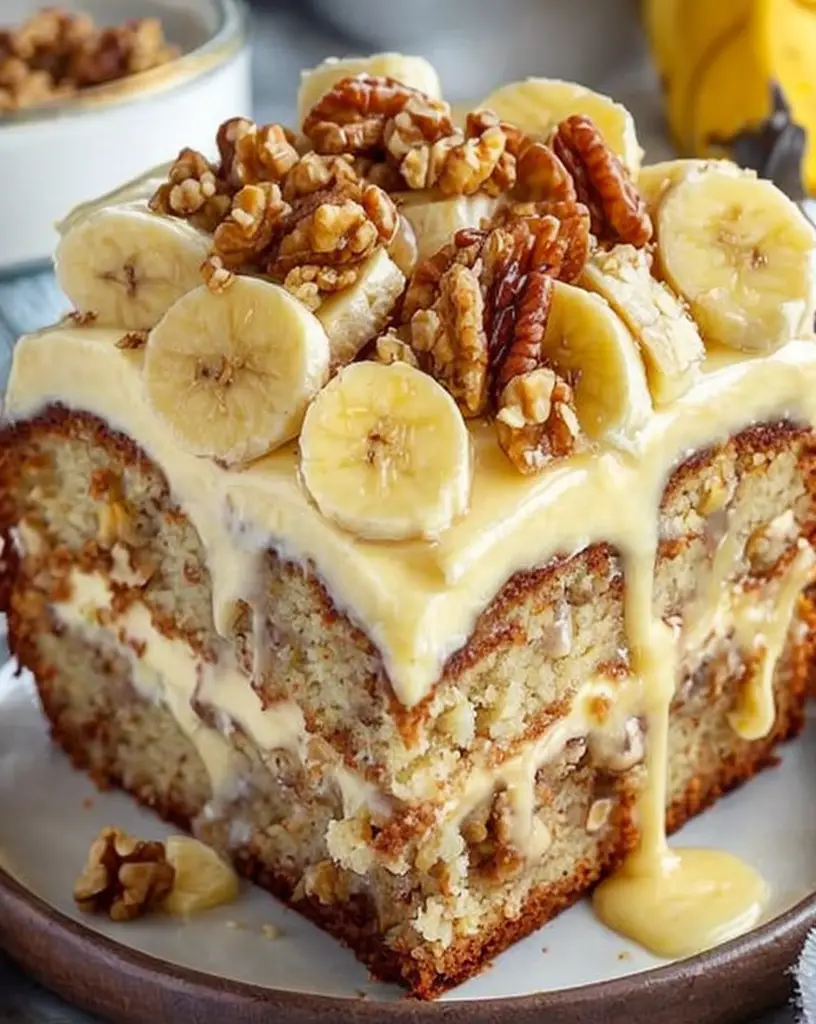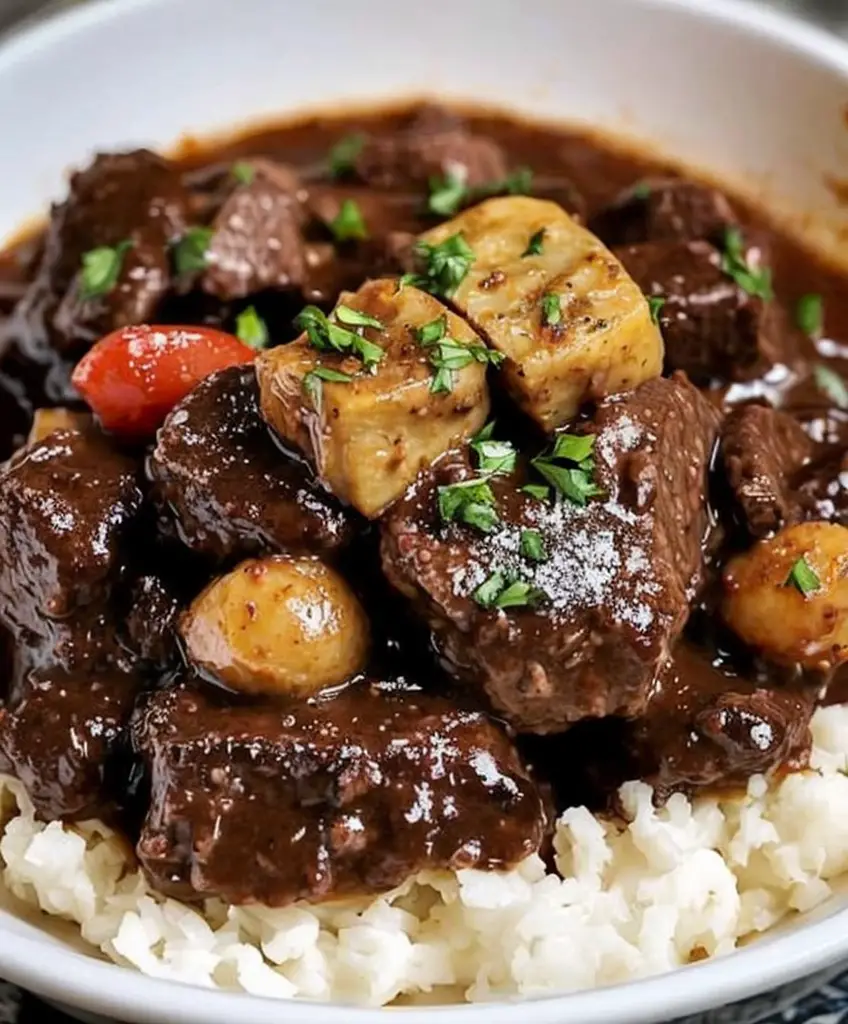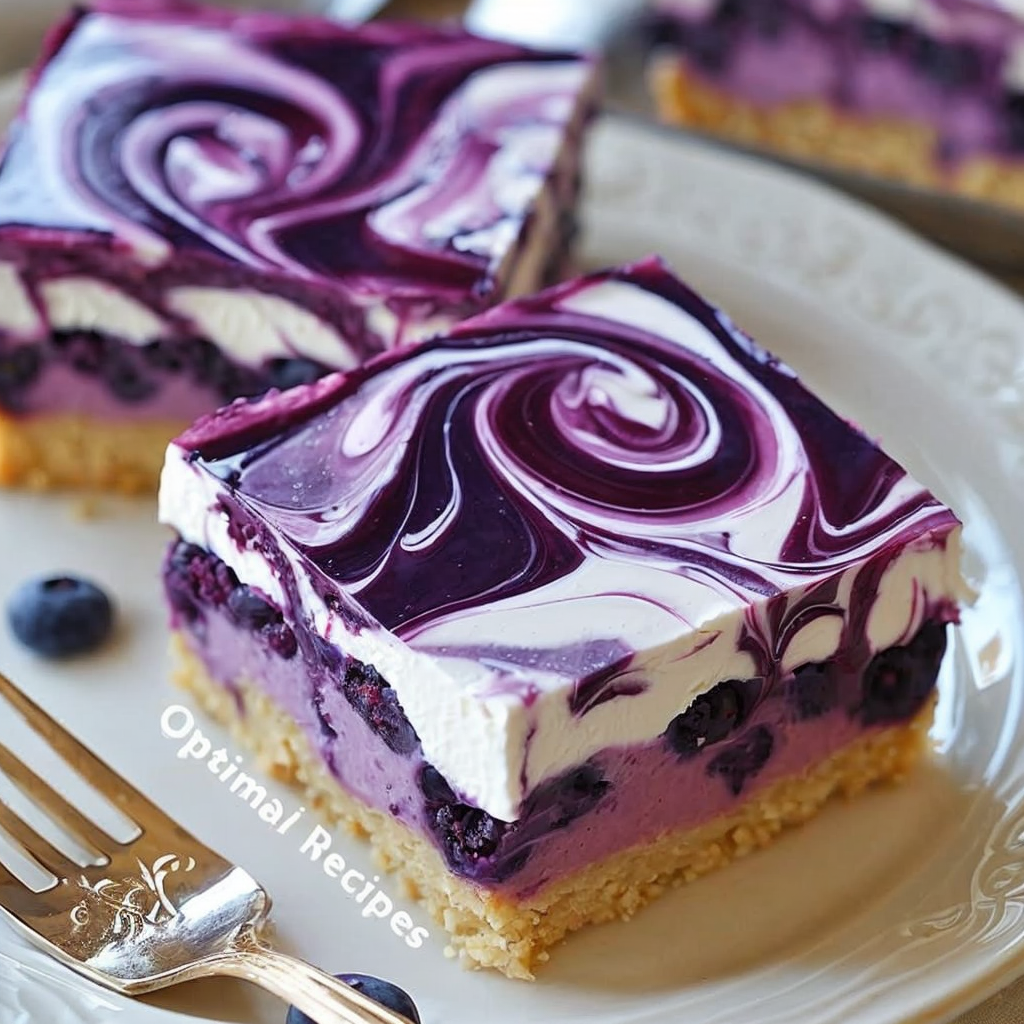Luscious Vanilla Banana Walnut Cake Recipe: A Deliciously Moist Treat
The Luscious Vanilla Banana Walnut Cake is a perfect dessert for any banana lover. This cake is incredibly moist, thanks to the ripe bananas, and is further enhanced by a rich vanilla flavor that fills every bite. Nuts add a delicious crunch, making this cake not just a treat for the palate but also a delight for the texture lovers. Whether it’s a cozy family gathering or a festive celebration, this cake is sure to impress all your guests and leave them craving more.
Picture this: a slice of warm banana walnut cake, drizzled with a creamy vanilla glaze, served alongside a cup of freshly brewed coffee or tea. The combination of flavors and aromas creates a warm, inviting atmosphere in your kitchen that embraces everyone who walks in. From the moment you take the first bite, the delightful mix of sweetness from the bananas and the earthy nuttiness from walnuts will transport you to dessert bliss.
Quick Recipe Highlights
- Flavor Profile: The cake balances sweet banana flavor with vanilla undertones and crunchy walnuts, creating a delightful harmony.
- Texture: Every slice boasts a moist and fluffy interior, complemented by a crispy exterior from the roasted walnuts.
- Aroma: The warm, inviting scent of freshly baked vanilla and ripe bananas fills your kitchen.
- Visual Appeal: With a golden brown top and flecks of walnut, this cake is not just tasty but also visually stunning.
- Skill Level Needed: This recipe is perfect for beginner bakers and experienced ones alike, ensuring success for all.
- Special Equipment: A standard mixing bowl, whisk, and a loaf pan are all you’ll need to create this luscious cake.
Recipe Overview
- Difficulty Level: The Luscious Vanilla Banana Walnut Cake requires medium baking skills, focusing on the proper mixing and baking techniques to ensure perfect texture.
- Category: This delicious cake can be categorized as a dessert or special occasion bread, making it versatile for various meals.
- Cuisine: Rooted in American cuisine, this cake brings together traditional baking methods with homemade charm.
- Cost: The ingredients for this cake, like bananas, flour, and walnuts, are quite affordable and often found in most kitchens.
- Season: Bananas are available year-round, making this cake an excellent choice for any season.
- Occasion: This cake is perfect for birthdays, holidays, or simply as an afternoon treat with friends or family.
Why You’ll Love This Recipe
The lush flavor and unique texture of the Luscious Vanilla Banana Walnut Cake offer a delightful combination that is perfect for any occasion. The sweetness of ripe bananas melded with the richness of vanilla creates a symphony of flavors that is nothing short of extraordinary.
Not only is this cake tantalizing to the taste buds, but it is also incredibly easy to prepare. With straightforward steps and common ingredients, you can whip up this dessert with minimal fuss and in no time at all. The process of mixing the ingredients is an enjoyable cooking experience that anyone can take part in.
This banana walnut cake provides nutritional benefits as well! Bananas are rich in potassium, while walnuts are a great source of omega-3 fatty acids, providing a satisfying treat that nourishes the body as well. Indulging in a slice of this cake can make you feel good both inside and out.
Sharing this cake at gatherings not only satisfies sweet cravings but also serves as an excellent conversation starter. Friends and family will appreciate the homemade touch, and their compliments might inspire you to create more delightful desserts.
Historical Background and Cultural Significance
The origin of banana bread and cakes can be traced back to times when families sought ways to utilize overripe bananas. This cake stands among a long tradition of creative baking that celebrates resourcefulness in the kitchen.
Banana walnut cake holds a special place in American baking culture, often associated with home economics in schools where practical life skills are taught. This recipe creates a sense of nostalgia, reminding many of baking sessions with loved ones.
As new ingredients and methods have evolved, variations of banana cake recipes have emerged, incorporating spices, frostings, and different kinds of nuts. The classic combination of bananas and walnuts, however, remains a cherished favorite.
Regional variations also exist, where added spices such as cinnamon or even chocolate can make their way into the batter. Each family adapts the recipe to their taste preferences, creating a rich tapestry of ways to enjoy this beloved dessert.
Ingredient Deep Dive
Bananas: Ripe bananas are essential for achieving the desired sweetness and moisture in this recipe. Along with flavor, they provide nutritional benefits like potassium and dietary fiber. When selecting bananas, look for ones with a rich yellow peel with a few brown spots, indicating perfect ripeness. Store them at room temperature or refrigerate if they’re too ripe to prevent further ripening. If you want to substitute, consider using applesauce for a lower-calorie option, though the flavor will vary.
Walnuts: These nuts provide a crunchy texture and a hint of bitterness that beautifully contrasts the sweetness of bananas. They are rich in protein and beneficial fats. Choose fresh walnuts with little to no blemishes, and store them in a cool, dry place to maintain freshness. You can easily swap walnuts for pecans or almonds if preferred, albeit altering the taste profile slightly.
Common Mistakes to Avoid
- Using unripe bananas: This will result in a less sweet cake. Always use fully ripe bananas for the best flavor and moisture.
- Overmixing the batter: This can create a dense cake. Mix just until the ingredients are combined to retain the fluffiness.
- Not measuring ingredients accurately: Baking is a science! Ensure you measure your flour and sugar for consistency.
- Baking at the wrong temperature: An oven that’s too hot can lead to burnt edges. Always preheat your oven and use an oven thermometer if needed.
- Skipping greasing the pan: This can lead to uneven baking and sticking. Make sure to properly grease your loaf pan before pouring in the batter.
- Rushing the cooling process: Allow the cake to cool in the pan for a bit before transferring to a rack to prevent it from falling apart.
- Not tasting the batter: Sampling the batter can help you adjust sweetness or add spices as needed.
- Using stale walnuts: Old nuts can make your cake taste rancid; always use fresh ingredients for the best results.
- Ignoring the altitude: High altitudes can affect baking times and ingredient quantities, so adjust accordingly.
- Not letting the cake sit before slicing: This can make cutting messy. Let the cake rest for a better texture and easier slicing.
Essential Techniques
Mastering the creaming method is vital because it incorporates air into the batter, leading to a light, fluffy cake. To do this effectively, beat the butter and sugar together until light and fluffy. Common pitfalls include not using room-temperature ingredients or not mixing long enough. The batter is ready when it’s pale and fluffy, with a pale yellow color.
Another key technique is the folding method, especially when incorporating dry ingredients into the wet mixture. It’s crucial to gently combine without deflating the batter. Use a spatula and fold in a circular motion while scraping the bowl’s sides. Look for visual cues of a consistent batter to determine if it’s well combined.
Pro Tips for Perfect Luscious Vanilla Banana Walnut Cake
1. Use the ripest bananas possible. The riper the bananas, the sweeter and more flavorful your cake will be.
2. For even mixing, ensure all ingredients are at room temperature before combining to promote a smooth batter.
3. Add a teaspoon of cinnamon for an extra layer of flavor that complements the bananas perfectly.
4. For more moisture, substitute half of the oil with plain yogurt or applesauce.
5. Top your cake with a light vanilla glaze or cream cheese frosting for a gourmet touch.
6. Fresh walnuts can be toasted lightly before adding to the batter, enhancing their flavor and adding a crunch.
7. Use a toothpick to check for doneness; it should come out clean or with just a few crumbs.
8. Store leftover cake in an airtight container to maintain freshness for several days.
Variations and Adaptations
For a tropical twist, you can mix in shredded coconut or diced pineapple for added flavor and moisture. During the fall, adding pumpkin puree along with the banana creates a seasonal delight.
If you’re looking for dietary modifications, consider making the cake gluten-free by substituting regular flour with a gluten-free blend. This change allows those with dietary restrictions to enjoy the cake without sacrificing flavor.
Flavor variations can also include dark chocolate chips for an extra indulgent treat. Simply fold them into the batter before pouring into the pan.
Presentation alternatives can include serving the cake on a decorative cake stand, garnished with fresh banana slices and a dusting of powdered sugar for an elegant touch.
Serving and Presentation Guide
When serving the Luscious Vanilla Banana Walnut Cake, consider using a serrated knife for clean slices. For an inviting presentation, arrange slices on a platter with a sprinkle of powdered sugar and fresh fruit for a pop of color.
Garnishing with a dollop of whipped cream can elevate the dessert experience, while a scoop of vanilla ice cream adds a delightful contrast in temperature.
Consider serving warm cake with a side of hot beverages like coffee or herbal tea to create a cozy ambiance. If choosing to showcase, a drizzle of chocolate sauce or caramel on the plate can be visually appealing.
Portion control can easily be managed with pre-sliced pieces, ensuring that every guest receives equal portions, making for a more organized serving experience.
Wine and Beverage Pairing
Sweet wines like Moscato or a light Pinot Grigio can complement the sweetness of banana walnut cake. A dry red wine, like a Merlot, can also pair nicely, balancing the flavors without overpowering them.
For non-alcoholic alternatives, a creamy chai latte or freshly brewed iced tea can be delightful accompaniments that highlight the cake’s flavors.
If you prefer coffee, a rich espresso would work well, enhancing the cake’s vanilla essence while harmonizing with the walnut’s nuttiness.
Always consider serving your beverages at the appropriate temperature, as a warm beverage will contrast nicely with the coolness of the cake, creating an interesting tasting adventure.
Storage and Shelf Life
Store your Luscious Vanilla Banana Walnut Cake in an airtight container at room temperature for up to 3 days. For longer storage, wrap the cake in plastic wrap and refrigerate, where it can last for about a week.
If you have a lot of cake left over, consider freezing it. Slice the cake and wrap each piece individually in plastic wrap before placing them in a freezer-safe container. It can last up to 3 months in the freezer.
Signs of spoilage include visible mold growth or off flavors. If you suspect spoilage, it’s best to discard the cake to avoid foodborne illnesses.
When ready to enjoy frozen cake, thaw it overnight in the refrigerator and bring it to room temperature before serving for the best texture and flavor.
Make Ahead Strategies
Prepare your Luscious Vanilla Banana Walnut Cake in advance by mixing the batter and storing it in the fridge for up to 24 hours before baking. This allows the flavors to meld overnight.
You can also bake your cake a day prior to your event and store it covered at room temperature or in the fridge, enhancing its taste and texture the next day.
To optimize quality, let the cake cool completely, then wrap it tightly in plastic wrap to prevent moisture loss and keep it fresh.
Add fresh elements, such as cream or fruit toppings, just before serving to maintain their freshness and appeal.
Scaling Instructions
When halving the recipe, simply divide each ingredient’s quantity by two while monitoring the baking time, as it may reduce slightly. It’s best to use smaller pans to avoid uneven cooking.
For doubling or tripling the recipe, use a larger mixing bowl to accommodate the increased volume. Keep the baking times in mind as larger quantities may take longer to bake through completely.
If using larger pans, you may need to adjust baking time and check for doneness by inserting a toothpick in the center; it should come out clean.
Store any extra batter in the refrigerator for later use, ensuring it is covered to prevent drying out. Ensure to keep an eye on the baking time as additional layers or thicker cakes may need more cooking time.
Nutritional Deep Dive
The nutritional profile of the Luscious Vanilla Banana Walnut Cake is rich, particularly with the inclusion of bananas and walnuts. One slice typically contains around 180-220 calories, depending on the serving size and specific ingredients used.
This cake provides healthy carbs primarily from bananas, giving you an energy boost, while walnuts contribute beneficial omega-3 fatty acids. The addition of vanilla extract can also provide slight antioxidant properties.
While delicious, this cake should ideally be enjoyed in moderation due to its sugar and calorie content. Pairing it with fresh fruit can round off the nutritional profile.
For those managing weight or looking to enhance dietary fiber, consider reducing sugar by using alternative sweeteners or adding chia seeds for more fiber and nutrients.
Dietary Adaptations
This luscious cake can easily be made gluten-free by opting for a gluten-free all-purpose flour blend. Ensure to check all other ingredients for gluten cross-contamination.
Create a dairy-free version by swapping butter with coconut oil or a vegan butter substitute while ensuring the milk used is plant-based, such as almond or oat milk.
For a vegan option, incorporate flaxseed meal as an egg replacement using one tablespoon flaxseed mixed with three tablespoons of water to replace each egg in the recipe.
For low-carb adaptations, consider using almond flour instead of regular flour and a sugar substitute like erythritol to keep the cake sweet.
Troubleshooting Guide
If your cake is too dense, it may be due to overmixing. Ensure you mix just until combined and incorporate ingredients property. If the cake is flavorless, try increasing the vanilla extract or bananas to enhance moisture and taste.
For cakes that sink in the middle, this can often be due to not baking long enough or sudden changes in temperature during baking. Always use an oven thermometer to maintain the correct temperature.
If you face challenges with uneven cooking, try positioning the cake in the center of the oven and adjust the rack if necessary.
When altering ingredient ratios, closely monitor the cake to ensure a balanced texture. For instance, too much flour can lead to dryness—so be cautious!
Recipe Success Stories
Variations such as chocolate chip additions or experimenting with spices have resonated well with the baking community, inspiring many to share their unique takes on this classic recipe.
Adaptation stories, including swapping walnuts for pecans, have proven just as delicious and have encouraged bakers to experiment without fear.
Photography tips shared by readers have helped to showcase the cake’s beautiful color, texture, and garnishes, improving engagement on social platforms.
Frequently Asked Questions
Yes, frozen bananas work well for this cake! Let them thaw and mash them to incorporate into your batter for incredible moisture.
2. How do I know when the cake is done?
The cake is done when a toothpick inserted into the center comes out clean or with a few crumbs, but not wet batter.
3. Can I bake this using a different pan size?
Absolutely! Just keep in mind that baking times will vary. A larger pan may require less time, so keep an eye on it.
4. How do I store leftovers?
Store in an airtight container at room temperature for a few days, or refrigerate for a week. You can also freeze it for longer storage.
5. Can I add chocolate chips to the batter?
Yes, adding chocolate chips is a delightful variation! They pair great with the bananas and walnuts.
6. Is it possible to use a sugar substitute?
Yes, you may use sugar substitutes like stevia or erythritol, but be cautious of the conversion ratios and follow package instructions.
7. Can I make this cake dairy-free?
Absolutely! Substitute the butter with a dairy-free alternative and use non-dairy milk for a completely dairy-free cake.
8. What’s the best way to mash bananas?
Use a fork or potato masher and mash until they reach a smooth consistency. Having no lumps will create a better cake.
9. How can I make my cake more flavorful?
Adding spices like cinnamon, nutmeg, or even a splash of vanilla extract can significantly enhance the flavor of your cake.
10. What’s the shelf life of this cake?
At room temperature, the cake is good for about 3 days. Refrigerating can extend it for about a week, while freezing can last up to 3 months.
Additional Resources
For more banana-inspired recipes, explore options such as banana bread, banana pancakes, or banana smoothies. Technique guides on baking will also enhance your skills.
Checking out ingredient information on bananas and walnuts might provide insights for various health benefits and further encourage wholesome baking habits.
Additionally, reading about the essential kitchen equipment can streamline your baking process.
Whether you look for seasonal variations or different desserts with similar flavor profiles, the world of baking offers endless possibilities to explore!
Join the Conversation
We love hearing from our readers! Share your baking successes on social media using our hashtag and show off your beautiful creations.
Photography tips can help you capture the essence of your baking. Try natural lighting and a clean background for stunning food photos.
Your reviews and feedback shape our community, inspiring new recipes and variations that cater to everyone’s taste buds.
Share your creative twists on this recipe to engage with fellow bakers and inspire their next kitchen adventure!
The Recipe
Luscious Vanilla Banana Walnut Cake
Serves: 8 slices
Prep Time: 15 mins
Cook Time: 30 mins
Total Time: 45 mins
Kitchen Equipment Needed
- Mixing bowl
- Whisk
- Loaf pan
- Measuring cups and spoons
- Spatula
Ingredients
- 3 ripe bananas, mashed
- 1/2 cup unsalted butter, softened
- 1 cup sugar
- 2 large eggs
- 1 teaspoon vanilla extract
- 1.5 cups all-purpose flour
- 1 teaspoon baking soda
- 1/2 teaspoon salt
- 1 cup walnuts, chopped
Directions
- Preheat the oven to 350°F (175°C) and grease your loaf pan.
- In a mixing bowl, cream the softened butter and sugar until light and fluffy.
- Add the mashed bananas, eggs, and vanilla extract. Mix until well combined.
- In another bowl, whisk together flour, baking soda, and salt. Gradually add to the banana mixture and stir until just combined.
- Fold in the walnuts.
- Pour the batter into the prepared loaf pan and smooth the top.
- Bake for 30-35 minutes or until a toothpick comes out clean.
- Let it cool in the pan for about 10 minutes before transferring it to a wire rack to cool completely.
Recipe Notes
- Store any leftover cake in an airtight container at room temperature for up to 3 days.
- For extra moisture, you can add yogurt or applesauce.
- Feel free to customize by adding chocolate chips or swapping walnuts for other nuts.




